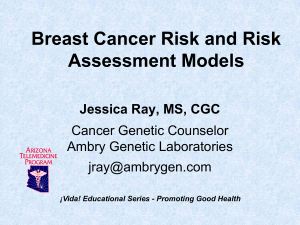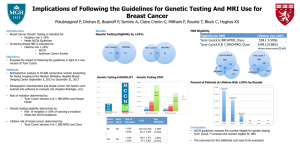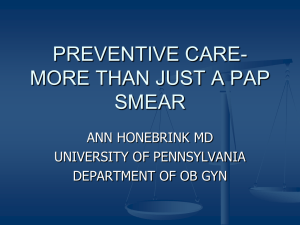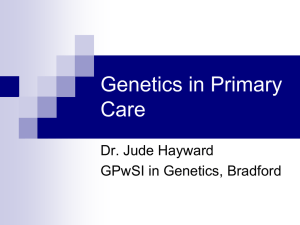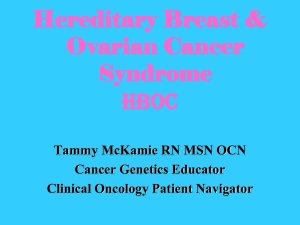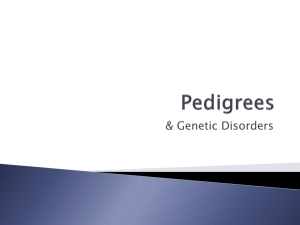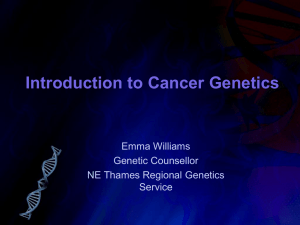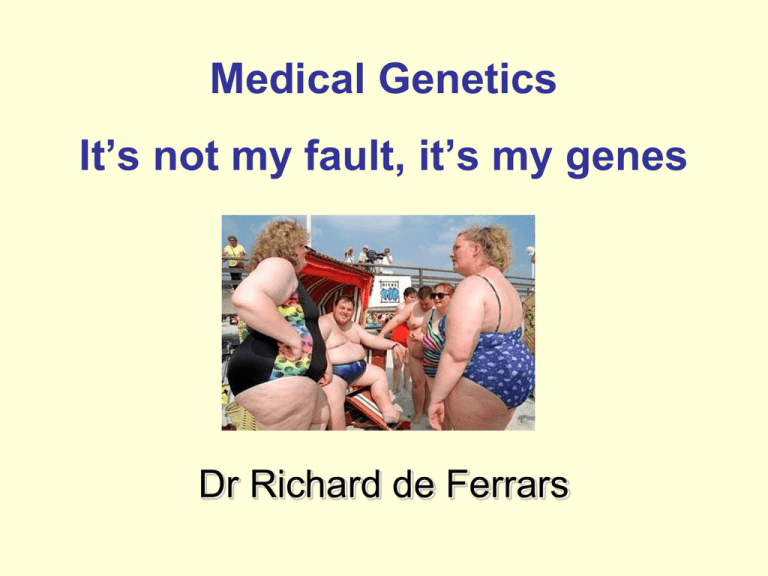
Medical Genetics
It’s not my fault, it’s my genes
Dr Richard de Ferrars
Why Bother?
Medical genetics is a complex and highly specialised field.
Why should I need to know about it as a GP?
It isn’t my problem….
Why might genetics be of relevance to you as a GP?
Why Bother?
Why Bother?
10% of the patients seen in GP have a disorder with a genetic component
- identifying patients with, or at risk of, a genetic condition
- clinical management of genetic conditions
- communicating genetic information
Taking and considering a genetic family history is a key skill
Role in identifying patients and families who would benefit from being
referred to appropriate specialist genetic services
Key part in discussing results from the antenatal and newborn screening
programmes which are identifying carriers and people affected
Research studies offer additional information about risk factors to aid
management
What Should You Know?
• Basic understanding of clinical
genetics
• Be able to draw, and
understand, a family tree
• Have awareness of when you
should be considering a
genetic condition
• Have a working knowledge of
the most important genetic
conditions
• Know how & when to refer to
local specialist genetics
services
What Types of Conditions?
Can you think of conditions where “genetics”
may arise in GP practice?
Categorise these “genetically”
Categories of Genetic Disease
• Genetic component of multifactorial illnesses
– Polygenic conditions
– Interaction of genetic & environmental factors
• Addition or deletion of entire chromosomes or
parts of chromosomes
• Single gene disorders
– Autosomal dominant
– Autosomal recessive
– X-linked
Multifactorial – Genes or Environment?
100%
Environmental
Struck by lightning
Infection
Weight
Cancer
Diabetes
Height
100%
Genetic
PKU –genetic basis
but the damage is by
an environmental agent
Sex, Down syndrome, achondroplasia
Categories of Genetic Disease
• Genetic component of multifactorial illnesses
– Polygenic conditions
– Interaction of genetic & environmental factors
• Addition or deletion of entire chromosomes or
parts of chromosomes
• Single gene disorders
– Autosomal dominant
– Autosomal recessive
– X-linked
Chromosomal Disorders
Most mutations happen in the parent’s egg/ sperm
- “one off” with no established family history
Duplications (whole or part)
Autosome trisomies (Down, Edwards, Patau)
XY duplications (Klinefelter XXY, Triple X)
Deletions
Autosome deletions (Cri du chat, di George’s)
XY deletions (Turner XO)
Translocations
Leukaemias (Philedelphia Chromosome)
Sarcomas (Ewings)
Inversions
Rings…..
Chromosomal Disorders
Most mutations happen in the parent’s egg/ sperm
- “one off” with no established family history
Genetics & the role of GP?
Transmission – unlikely
Reassurance within affected families
Antenatal screening?
Bread and butter CSA station...
Categories of Genetic Disease
• Genetic component of multifactorial illnesses
– Polygenic conditions
– Interaction of genetic & environmental factors
• Addition or deletion of entire chromosomes or
parts of chromosomes
• Single gene disorders
– Autosomal dominant
– Autosomal recessive
– X-linked
Single Gene Disorders
• Transmitted in a Mendelian fashion
– Autosomal dominant, autosomal recessive
– X-linked, Y-linked
• Variable Penetrance
Some conditions have 100% penetrance eg acondroplasia
Many don’t. Why not?
Genetic factors – effect from genes at other alleles
Environmental factors – eg BRAC & no. of pregancies
Let’s go drawing......
Family Tree Symbols
Male
Female
Marriage / Partnership
(horizontal line)
Partnership that has
ended
/
Person whose sex is
unknown
P
Offspring (vertical line)
Pregnancy
Pregnancy/ abortion
X weeks/ years
Age at time of event
Deceased aged 76
76
Affected Male & Female
Parents and Siblings
Carrier Male & Female
JH (28) is 6w pregnant and wishes to discuss cystic fibrosis
risk as her nephew RW had cystic fibrosis diagnosed on
screening. His brother (JW) is unaffected
Her husband, CH (29), is an only child. His father, WH (60)
and mother, MH (59) are fit and well
Her father, GW, died aged 66 from an MI. Her mother JW,
is A&W aged 64
Her brother, JW, is aged 34 and well
JW’s first marriage was to AW (33) and they have one well
child DW (10)
JW’s second marriage is to CW (29) . She knows no details
of her parents. She had one spontaneous abortion (at 9w)
before RW, who is now 3
JW (64)
AW (33)
DW (10)
JW (34)
9w
GW (
CW (29)
RW (10)
Cystic
Fibrosis
66 MI)
WH (60)
MH (58)
CH (29)
JH (28)
6w
Generations may appear
unaffected.
Often “distant” family history
What inheritance pattern?
Autosomal Recessive Inheritance
Parents
Carrier
Carrier
Gametes
Conception
Unaffected
Carrier
Affected
Autosomal Recessive Inheritance
Name some AR conditions:
Cystic Fibrosis
Haemachromatosis
Sickle cell disease
Thalassaemia
PKU
Glycogen storage diseases
You must know the illnesses & inheritance pattern
Bread and butter CSA cases...
Discussing a FH
Discussing antenatal screening & diagnosis
Cystic Fibrosis
• One of the most common AR conditions
Mutation of CTFR gene on chromosome 7
900 mutations identified (racial variations)
2 defects cause problems irrespective of type
• Carrier Rates
1 in 25 carriers
2 in 3 carriers
1 in 2 carriers
1 in 4 carriers
1 in 16 carriers
UK general population
brother/sister
aunt/ uncle
1st cousin
2nd cousin
Cystic Fibrosis
Screening & Detection
- Screening of newborn – “Immunoreactive Trypsin”
- Preconceptual gene testing for positive FH
- even in 2nd cousin
Limitations:
screen for most common mutations only
(screen negative not “all clear”)
does not predict disease severity
Options if affected:
donor egg/ sperm
pre-implantion embryo screening
CVS and termination
Autosomal Dominant Pedigree
Typically every generation affected
Autosomal Dominant Inheritance
Parents
Affected
Gametes
Conception
Unaffected
Affected
Autosomal Dominant Inheritance
Name some AD conditions:
Huntingdon’s Disease
Adult polycystic kidney disease
Neurofibromatosis
You must know the illnesses & inheritance pattern
Bread and butter CSA cases...
Discussing a FH
Discussing antenatal screening & diagnosis
Huntingdon’s Disease
Gene for protein Huntingtin on
Chromosome 4
Contains a sequence of “tri-nucleotide
repeats”, in this case CAG
Produces chains of glutamine, length
depends on number of repeats
- Under 26 repeats is normal
- Over 36 repeats generates
abnormal Huntingtin that
kills cells
More repeats = more severe HD at
younger age
Huntingdon’s Disease
Inheritance is autosomal
dominant
But long repeat sequences are
“unstable” and number of
repeats can alter between
generations
Other genes & environmental
factors also affect the
activity of the gene
The result - strong penetrance
but variety in age of onset &
severity
Huntingdon’s Disease
• John is seen in a genetics clinic after his mother has a
confirmed diagnosis of HD.
• He is married to Sarah and they have a 6 y/o child, Tom.
• After counselling John decides that he will NOT take a
test at present due to the absence of treatment and the
long time interval before any symptoms would arise.
• Sarah comes to see you. She explains how distressed
she is by witnessing the deterioration in John’s mother.
She feels she needs to be prepared if Tom has inherited
the condition and requests referral for Tom to be tested.
Discuss this case in 2-3 and then review “issues”
X-Linked Pedigree
Red-green colour blindness (7%)
Haemophilia
Duchenne MD
Fragile X
Males only affected – can appear to skip generations
Polygenic Diseases
• The most common yet still the least understood
of human genetic diseases
–
–
–
–
Type I and type II diabetes
Primary generalised osteoarthritis
Hypertension
Autism
• Result from an interaction of multiple genes,
each with a minor effect
• Some inherited mutations and some
environmental factors (somatic mutations)
Multifactorial Diseases
Normal
Gene
Normal
Tissue
Cancer
Hereditary
Mutation
(Recessive Trait)
Normal
Tissue
Cancer
Somatic
Mutation
Normal
Tissue
Polygenic Diseases
Normal
Tissue
Cancer
Normal
Tissue
Polygenic Disease Pedigree
Less pattern – more scattered
Cancer Families
“Doc – I’ve got cancer in
the family
Should I be worried?”
Beware of the elephant
in the room….
Case History 2
Breast cancer
65
70
46
Kay
76
49
51
53
55
Breast Cancer Genes
BRCA1, BRCA2 possible BRCA3?
• Tumour supressor genes, generate protein involved in
DNA repair, destroys cell if DNA cannot be repaired
• Several hundred mutations have been identified, varying
effect on gene function
• Racial variation – Ashkenazi Jews
• The gene functions in other tissues – hence the “related
cancers” effect, most noticeably ovary (fallopian tubes &
prostate)
Lifetime risk of - breast cancer 50 - 85%
- ovary cancer BRCA1 44%, BRCA2 27%
Breast/ Ovary Cancer
Ignore “one cancer only, age over 40y”. Everything else – check guidelines
Case History 2
Low risk
Manage in primary care
Older age of onset
65
Different sides of the
family
Breast cancer
70
46
Kay
76
49
51
53
Reassure and explain population risk, advise on symptom
awareness and to report any changes in family history
55
Case History 3
Refer –high risk
Breast and ovarian cancer
Multiple tumours in one
individual
Young age onset
Different generations
42
Equal transmission
through men
48 breast cancer
56 ovarian cancer
Breast cancer
Ovarian cancer
32
Janet
35
Familial Colorectal Cancer
Colorectal cancer common – 1 in 25
5-10% - strong genetic contribution
The most important of these are:
- familial adenomatous polyposis (FAP)
- hereditary non-polyposis colorectal
cancer (HNPCC)
Most are autosomal dominant – not all!
Bowel & Related Cancers
A close relative is any 1st or 2nd degree relative (parent, sibling, aunt, uncle, grandparent) on either
paternal or maternal side of the family
Related Cancers: endometrial, ovarian, gastric, biliary, renal, small bowel & brain
Ignore 1 cancer aged over 45yrs or 2 cancers both
over 70yrs. Everything else - check guidelines
Case History 4
Refer –moderate risk
Two close relatives
average age under 70 yrs
35
died in war
60’s
73
77
73
75
43
Colorectal cancer
32
Peter
68
78
Case History 5
Refer –high risk
Young age of onset
Endometrial cancer with
bowel family history
(other related cancers:
ovarian, ureteric, renal
pelvis, gastric)
55
69
49
Two generations
Polyps
42
80
75
48
George
Endometrial cancer
Colorectal
cancer
30
Martin
39
Polyps
42
78
Assessing Cancer Risk
• Stop and think …..
– young age of onset,
– pattern of similar tumours in a family
– multiple primaries in one individual
• Remember:
– Related tumours
– Ethnicity matters Ashkenazi Jewish ancestry
• Use national/local guidelines
– e.g. NICE familial breast cancer, websites
• Over 200 hereditary cancer syndromes described –
individually rare, but as a GP you will meet some
• Contact the CGS if you are unsure
Resources
GP Curriculum Map:
InnovAiT 1;8
Websites
Australian Handbook for GPs
http://www.nhmrc.gov.au/your_health/egenetics/practitioners/gems.htm
In my opinion, easier to find useful information about specific cancers
MacMillan - Cancer Genetics
http://www.macmillan.org.uk/Cancerinformation/Causesriskfactors/Genetics/Cancergenetics/Cancergenetics.aspx
University of Texas – Teaching Cases
http://genes-r-us.uthscsa.edu/resources/genetics/primary_care.htm
A good series of case reports to work through
– Explore various aspects of genetics in primary care
– American flavor but still useful!
And Finally…..
• What should you accumulate in your portfolio
over the 3 years?
– Teaching session…
– Log entries involving breast/ bowel cancer that link to
further educational activity
• Reading on National MacMillan/ Australian website
• University of Texas case reports
The End
What to do if a patient has a family history of Breast/Ovarian Cancer
A close relative is any first or second degree relative (parent, brother, sister, child, aunt, uncle, grandparent). Please
remember if there are intervening male relatives then more distant relationships maybe relevant.
The family history should be of affected blood relatives through either the maternal or paternal side of the family.
If there is Jewish ancestry in the family, the history may be more significant – seek advice from the Clinical Genetics service.
Refer affected patients and close female relatives.
For enquiries about a patient’s family history, or if there is a history of unusual cancers, please contact the Clinical Genetics
Service on : 0114 2717025.
Number of close relatives
affected by breast cancer
Family History of breast
cancer
Refer to combined FH clinic
(Breast Unit)
Age of cancer diagnosis
≤ 40
1 (first degree)
(bilateral)
> 40
< 50
(2nd primary can be over 50)
X
Any age
2 (one 1st degree)
Average age under 60
3 (or more)
Any age
(male)
OVARIAN CANCER FAMILIES
Number of close relatives
Action
affected by ovarian cancer
No screening
1
required
Refer to FH
2 or more
clinic
Key
Green is low risk
Orange is moderate or high risk
BREAST & OVARIAN CANCER FAMILIES
Number of close relatives affected by either breast or
Refer to
ovarian cancer
FH clinic
1
both breast and ovarian cancer
1
male breast cancer and 1
1
No action
required
Refer to FH clinic
breast and 1
3 or more
ovarian cancer
ovarian cancer (one 1st degree)
breast and/or ovarian cancer at any age
What to do if a patient has a family history of bowel and related cancers.
Key
Green is low risk
Orange is moderate risk
Pink is moderate to high risk
Red is high risk
Number of close relatives
with bowel cancer
1(1st degree)
1 (1st degree)
Age of cancer diagnosis
Refer to
FH clinic
<45
>45
x
Separate or multiple tumours at any age
More than one significant (>10mm) polyp under 50yrs
2 (same side or both parents)
Average age < 70
>70
2 (same side)*
Average age <50
x
Any age
Positive family history
1 (1st degree-polyps only)
3 or more (same side)*
Polyposis Coli
*Related cancers: When there is, in addition to at least one bowel cancer, a history of endometrial, ovarian, gastric, biliary, renal, small
bowel or brain cancer in other close relatives.
A close relative is any first or second degree relative (parent, brother, sister, child, aunt, uncle, grandparent).
The family history should be of affected blood relatives through either the maternal or paternal side of the family.
For enquiries about a patient’s family history, or if there is a history of unusual cancers, please contact the Clinical Genetics
Service on :0114 2717025.

